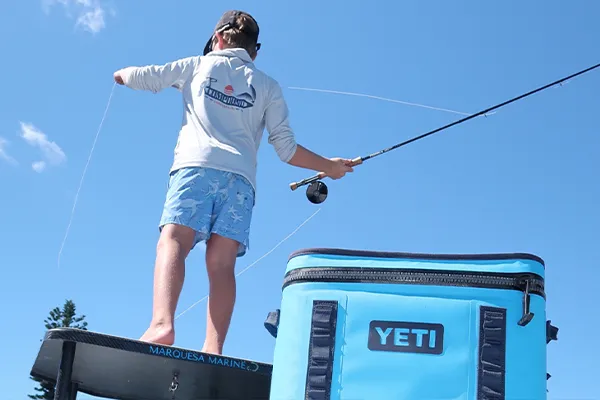
How to Teach Your Kid to Fly Fish (Beginner-Friendly Tips for 2025)
Teaching your kid to fly fish can be one of the most rewarding things you ever do—or it can end in tears, tangled line, and a quiet drive home.
Fly fishing is full of subtle technique, patience, and nuance. And let’s be honest: kids aren’t always known for those things. But with the right approach (and the right expectations), it doesn’t have to be frustrating.
In fact, it can be one of the most fun and meaningful experiences you share.
Here’s how to teach your kid to fly fish—without losing your cool or their interest.
Start With the Fun, Not the Technique
If you begin with foot placement, rod angles, and roll cast mechanics, you’re going to lose them before the first loop.
Instead, make the first session about fun.
Let them hold the rod.
Let them splash a little.
Let them play with the fly box.
Show them how to flick the line around on the lawn.

You’re not trying to mold the next Lefty Kreh in a weekend. You’re just planting the seed that fly fishing is exciting, hands-on, and theirs to explore.
Skip the Water (At First)
Trying to teach your kid to cast and deal with currents, wind, fish, or other distractions? That’s a recipe for frustration—for both of you.
Instead, teach casting on dry land.
A backyard, a park, or even an open driveway works perfectly. Use yarn instead of a fly or hookless flies so there's no chance of injury. Lay out hula hoops or buckets for targets. Make it a game.
Once they can confidently false cast, shoot line, and hit targets on grass, then take it to the water.
Lower Your Expectations (Like... Way Down)
Let’s be real. Your kid might not be ready to stalk spooky redfish in ankle-deep water with a perfect double haul. And that’s okay.
Focus on small wins:
Holding the rod correctly
Learning a basic roll cast
Getting the fly into the water
Catching anything (even a sunfish on a pond)
Fly fishing is a technical art form, but kids just want to do cool stuff and catch fish. Give them opportunities to do both—even if that means breaking some fly fishing “rules.”
Use the Right Gear for Their Size
Standard fly rods can be too long, too heavy, or too stiff for younger kids. Make sure their gear fits them.
A 6–7 ft rod in a 2–4 weight is ideal for most young beginners.
Use shorter leaders to simplify casting.
Consider a larger arbor reel if they’re using it to manage line (even though they won’t fight fish with it yet).

Bonus: brightly colored fly lines help kids see their loops and understand casting mechanics more intuitively.
Teach One Thing at a Time
Kids (and adults, honestly) learn better when they’re not overwhelmed. Instead of dumping everything you know onto them in one go, break it down.
Day 1: Just practice holding the rod and learning what everything is called.
Day 2: Try basic pickup and lay-down casts on the grass.
Day 3: Add in a roll cast.
Day 4: Move to the water and let them experiment.
Keep the sessions short. Celebrate effort, not perfection.
Focus on Success, Not Skill
When your kid feels successful, they’ll want to keep going. So set them up to win:
Pick easy-to-catch fish in stocked ponds or warmwater creeks
Use flies that increase the odds (like small woolly buggers or poppers)
Keep the action quick—if nothing’s biting, move on or take a break
Celebrate effort (“That was an awesome cast!”) just as much as outcomes
You’re not coaching a competition team—you’re building memories and confidence.
Let Them Do It—Even If It’s “Wrong”
As adults, it’s easy to micromanage. But if you’re constantly adjusting their grip, line, or timing, it stops feeling like their experience.
Let them make mistakes. Let them get tangled. Let them say, “I want to try this.” You’ll be surprised how quickly they learn by doing—and how much more they enjoy it.
Step in when asked, not at every wobble. Sometimes the best coaching is stepping back.
Capture the Moments, Not Just the Fish

They won’t always catch fish. But they will remember the time spent with you—especially if you make it feel like an adventure.
Take photos. Make jokes. Bring snacks. Let them dip their feet in the water. Let them cast into a puddle “just to see what happens.”
The more fun they associate with fly fishing, the more likely they are to keep doing it—and to one day teach their own kids.
Final Thoughts
Teaching your kid to fly fish isn’t really about perfect casts, knots, or the number of fish you catch. It’s about something bigger.
It’s about giving them a space to be curious, to learn by doing, and to develop real-world patience in a world that’s constantly trying to speed them up. It’s about showing them that effort matters more than outcome—and that there’s value in slowing down and paying attention to the world around them.
Yes, it takes patience. Yes, there will be tangles, missed hooksets, and the occasional meltdown. But every session is a chance to teach something meaningful—about nature, responsibility, resilience, and how to handle setbacks without giving up.
More importantly, it’s about connection.
When you teach your kid to fly fish, you're creating shared memories that don’t come from a screen or a schedule. You’re standing side by side in the quiet. You’re celebrating small wins together. You’re building a tradition that can last for decades.
One day, they won’t remember every fish. But they’ll remember how it felt to be there with you—casting into still water, laughing about tangled line, watching the sky change colors over the trees.
That’s the real catch.
So keep it light. Let go of the pressure to do it “right.” Make space for laughter, learning, and a few bad casts. Because the moments you’re building now? They’ll mean more than you know.
Want help getting your kid started?
Check out our Fly Fishing Basics section and grab our free checklist: Beginner Gear for Kids Who Want to Fly Fish.

Facebook
Instagram
Youtube
TikTok